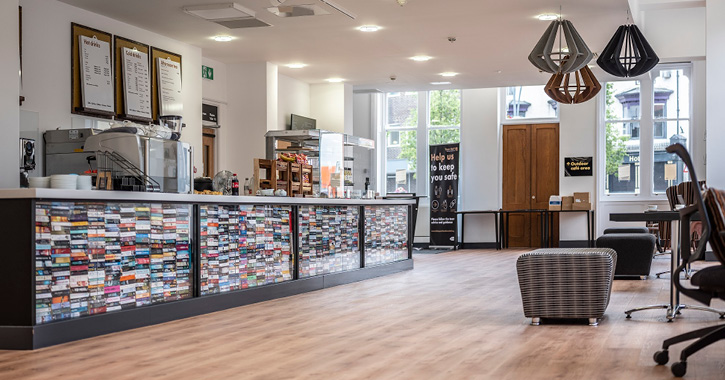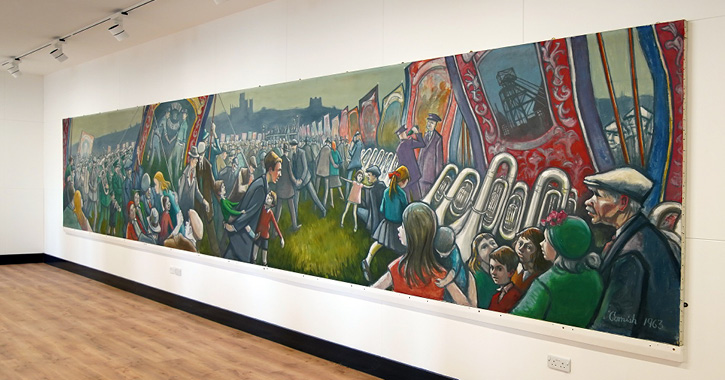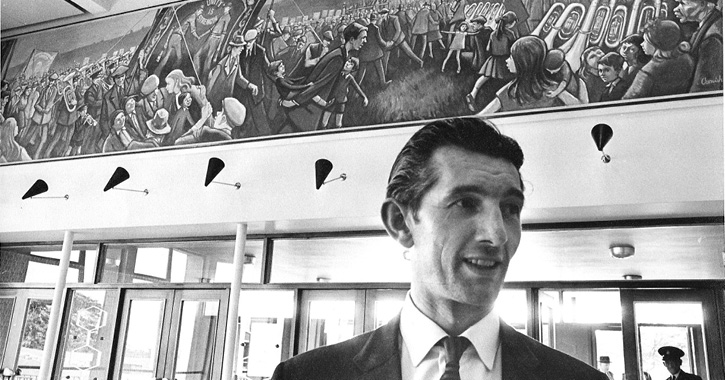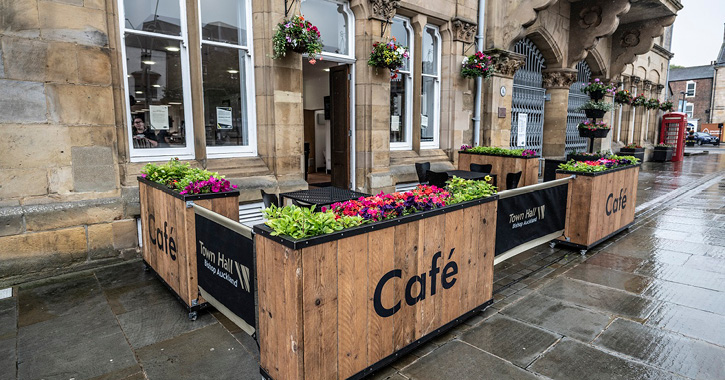The opening of the new look café at Bishop Auckland Town Hall will offer people a taster of a £1.5 million revamp of the historic town hall. The café is also the new home of Norman Cornish’s Miners’ Gala mural, which has been relocated from County Hall in Durham City.
The piece is on display alongside a stunning stained-glass feature by fellow local artist Tom McGuinness.

The story behind the Miners’ Gala Mural
Norman Cornish was born in Spennymoor in 1919 and worked as a coal miner before becoming a professional artist. In 1962 he was commissioned by Durham County Council to create the mural coinciding with the opening of the new County Hall in October 1963.
In 1962 the coal industry was in decline and Norman was also under pressure from his agent Mick Marshall at The Stone Gallery in Newcastle to become a full time professional artist – such was the demand for his work and a burgeoning national reputation.
Becoming a professional artist introduced different risks compared to those he faced underground on a daily basis. His house was ‘tied to the mine’ and irregular income added to the insecurity of making the ‘big step’ from miner to professional artist.
One day, working at the coal- face at Mainsforth Colliery, Ferryhill, he was summoned to receive an important telephone call from Durham County Council to commission Norman to paint a Mural typifying life in County Durham, for the new county hall.

Initially reluctant, he received support from his wife Sarah and also from Bob Heslop and Bert Dees who were also members of The Spennymoor Settlement Sketching Club. Norman was granted ‘leave of absence’ for twelve months, without pay, which sadly confirmed his view that the miners were treated like slaves.
The commission was conducted in secrecy and he was given permission to use a former church hall as a studio although it was draughty and without heating. Norman had to acquire his own materials including the canvas, which measured 30 feet 9 inches by 5 feet 8 inches. Norman didn’t own a telephone and letters were the only means of communication to suppliers of materials.
Four mining related subject themes were initially suggested by the council but Norman made an inspired choice with the arrival of the banners at The Race Course at The Durham Big Meeting- The Miners’ Gala.
Norman visualised the banners as representing the sails of a galleon with three waves of people in the sea of humanity below. All depicted with an undulating rhythm and counter rhythm to suggest movement.

The young people in the wave to the left represent the present and look towards the centre- the future. The elderly folk to the right, representative of the past, turn to the bold central banner which bears the slogan “Unity is Strength’- a symbol of the future. The whole scene represents an allegory of time.
Norman developed his composition by producing preliminary drawings and paintings based upon observations which become smaller versions of the final composition. This allowed Norman to be confident that by a series of steps, the final full -scale version actually worked in terms of the relationship between the figures and the overall composition.
Most of the work was completed during the coldest winter in 40 years and sometimes icicles had to be broken to access the hall. Often, Norman had to wear several coats to keep warm, a muffler, cap and gloves. A secret knock was devised to enable his closest friends to view the work in progress and offer helpful comments.
During his research, Norman made numerous drawings of Spennymoor Town Band members in rehearsal to ensure absolute accuracy. At a later stage he added himself and his son John, on his shoulders, (left hand side) as observers rather than participants, who are fundamental to the composition. It was important for Norman to depict himself as being part of the miners’ annual celebrations that reinforced his sense of belonging, involvement and affinity with his subject.

The Mural has been on display at Durham County Hall since the opening in 1963. Now visitors can see the mural at Bishop Auckland Town Hall where a fully accessible permanent exhibition will be installed when refurbishment is complete. The display will include previously unseen preparatory works, and correspondence from the Norman Cornish archive.
The Miners’ Gala Mural is a highly significant work of art that goes to the very heart of Durham culture and which evokes deepening and strengthening emotional attachments for many people who identify with this inspirational record of a bygone era.

Bishop Auckland Town Hall Café
Bishop Auckland Town Hall was due to reopen to the public earlier this year following a major refurbishment, but has been delayed due to the coronavirus pandemic.
The café is open Monday to Saturday, from 10am to 4pm, and there is no need to book in advance. Extra space has been created between tables in the café alongside additional signage to support social distancing.
Bishop Auckland Town Hall closed last August to enable the refurbishment scheme to be carried out. As well as significant improvements to the café and library, work has included the creation of a new gallery space and significant improvements to the auditorium.
Related
Comments
Comments are disabled for this post.



 to add an item to your Itinerary basket.
to add an item to your Itinerary basket.
.png)






